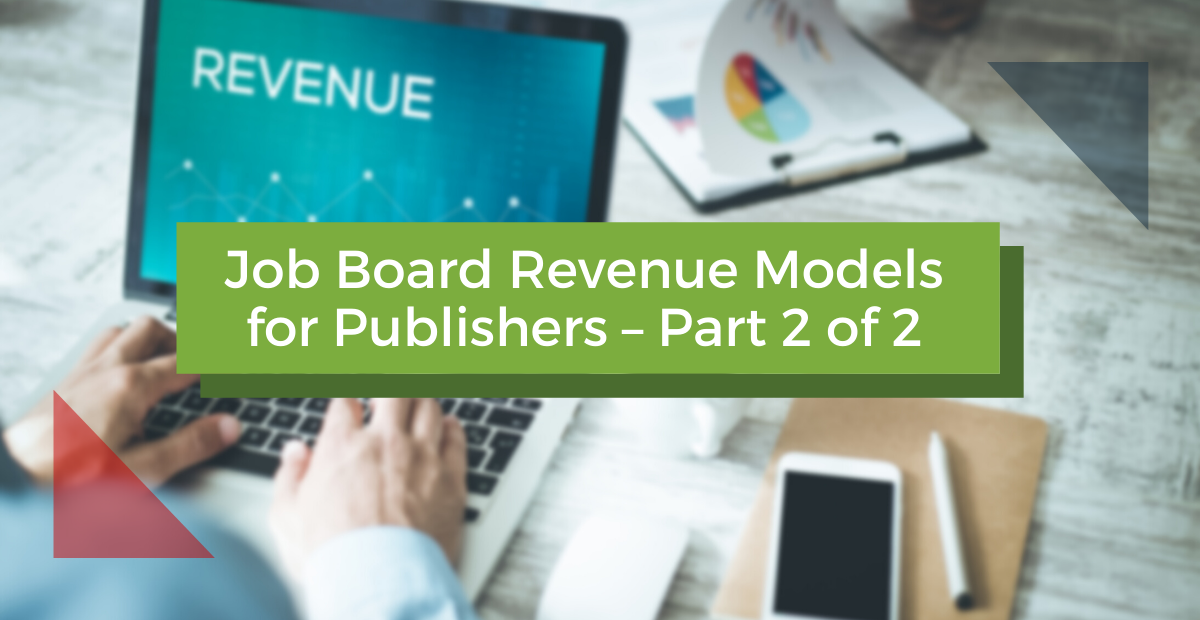This week we’re continuing our discussion of job board revenue models for publishers.
Online publishers – magazines, newspapers, blogs, news and media websites, and online communities centred around content – have dedicated readerships and established relationships with advertisers and benefit from generating revenue through job boards.
Last week we discussed the Job Page/Hands-Off model and the Print Sales Companion model. This week we’ll have a look at Revenue-Sharing, and the all-in-one Embedded Revenue Stream model.
The Revenue-Sharing Model
Like the Job Page/Hands-Off model, Revenue-Sharing is usually dependent on the technology provider you work with, and the deal you have with them. In general, a Revenue-Sharing model is one where sales made through your job board go directly to your technology provider first, who then returns a percentage of that revenue to you. Publisher job boards using a Revenue-Sharing model will likely need to make a minimum sales or revenue quota each month before seeing their share of the revenue.
The Pros:
- Low Barrier to Entry – Revenue-sharing models usually mean initial up-front costs are low. You also don’t have to handle regular payments, since you pay for your technology services through the revenue you generate.
The Cons:
- Shared or Diminished Branding – Similar to the Job Page/Hands-Off model, your job board is labelled with somebody else’s brand on your website. It’s also easy for users to be directed away from your site to the main aggregator or network with which you’re connected.
- Limits on Revenue – Forking over a percentage of every sale you make puts limits on how much money you can generate. It also means that if your job board is subject to seasonal variability in terms of job openings and searching, there may be some months you won’t meet your minimum commitments.
- Lack of Product & Pricing Control – Because your revenue is delivered to your technology provider first, you may not be able to create new products or adjust pricing as easily. There may be standard base pricing that you must adhere to, leaving less flexibility for you to experiment with pricing.
- Shared Database – Revenue-Sharing models usually also mean sharing your customer and candidate databases with your technology partner, which means the same goes for other publishers using the same service.
The Embedded Revenue Stream Model
The embedded revenue stream model involves approaching a job board as a fully-integrated component of the online publishing business, and not a secondary add-on. The embedded revenue stream model also takes most of the pros from the other models, and assumes that it you are not limited by your choice of technology provider.
The Pros:
- Existing Sales Channels – As with the Print Companion model, job ads can be sold by the same sales staff who work with classified advertisers, who deal with online display ad publishing agreements, and manage print ads, etc. Existing sales teams and customers just have more products and services to sell.
- White-Labelling – Using a solution that lets you showcase your brand on your job board lets you take advantage of your existing reputation and add further value to it. Job seekers and employers associate your job board’s value with your brand, and not that of your technology provider.
- Cross-Marketing Opportunities – Because this model integrations your job board’s operations with the rest of your publishing enterprise, there are lots of opportunities to promote your job board’s services, its jobs and employers, and your content. Calls to Action, mentions, and links to your content and job board can all be featured on your job board, on social media, in newsletters, emails, and in your online and print publications seen by your readers, advertisers, and other business partners.
- Diverse Revenue Streams – In addition to job posts and featured listings, you can monetize your candidate database, use job backfills, offer advertising upsells to employers in your regular online and/or print publications, and offer referral programs such as career services for job seekers and recruiting services for employers
The Cons:
- It’s Work – This is not a low-maintenance strategy. This is especially true if you’re just starting or re-launching your job board, as you’ll need to lay the ground work. It will require team effort and experimentation, and involves integrating your the marketing of your job board and its revenue generation in with the rest of your publishing business.
- Upfront Investment – Unlike the Job Page/Hands-Off or Revenue-Sharing models, the embedded revenue stream may not always be cheap. It may require some upfront investment and/or paying a regular fee for your technology solution, which can be barriers to entry for some.
Not every publisher job board will fit neatly into the revenue models we’ve outlined, but we hope that discuss the advantages, challenges, and revenue models for publisher job boards, you’ll be inspired to examine your job board or publishing business in a comparative light. For more ideas on how publishers can benefit from job boards, click here to learn about how Careerleaf helps publishers.

